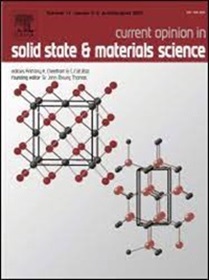Dissecting the physics of bacterial biofilms with agent-based simulations
IF 13.4
2区 材料科学
Q1 MATERIALS SCIENCE, MULTIDISCIPLINARY
Current Opinion in Solid State & Materials Science
Pub Date : 2025-05-31
DOI:10.1016/j.cossms.2025.101228
引用次数: 0
Abstract
Biofilms are surface-attached bacterial communities encased within extracellular matrices (ECMs) of biopolymers that play many significant roles in health and society. Biofilms are versatile, living biomaterials that are resilient to a wide range of external perturbations, primarily due to the ECM, which consists of a complex network of polymeric macromolecules. Newly established platforms for live biofilm imaging at single-cell resolution have revealed a wealth of novel insights into the emergence of cellular organization within a developing biofilm. This has, in turn, necessitated the development of modeling approaches that can pinpoint the mechanistic origins of this organization. In this review, we discuss the use of agent-based models (ABMs) as a general framework for simulating the development of bacterial colonies and biofilms. We describe the ingredients that are typically included in an ABM, together with the biological entity or process that each such ingredient represents, and the assumptions that underlie its precise formulation within the model. We then discuss a selection of recent studies in which ABMs have been used to investigate the physical mechanisms that govern biofilm development, focusing on our recent work on orientational ordering within Vibrio cholerae biofilms. Finally, we describe the numerous ways in which we foresee that ABMs can be leveraged to further our understanding of biofilm development.

用基于代理的模拟剖析细菌生物膜的物理特性
生物膜是包裹在生物聚合物细胞外基质(ecm)内的表面附着的细菌群落,在健康和社会中发挥着许多重要作用。生物膜是一种多功能的、有生命的生物材料,它对广泛的外部扰动具有弹性,主要是由于ECM,它由一个复杂的聚合物大分子网络组成。新建立的单细胞分辨率的活生物膜成像平台揭示了大量关于发育中的生物膜内细胞组织出现的新见解。反过来,这就需要开发能够精确定位该组织的机制起源的建模方法。在这篇综述中,我们讨论了使用基于主体的模型(ABMs)作为模拟细菌菌落和生物膜发育的一般框架。我们描述了ABM中通常包含的成分,以及每种成分所代表的生物实体或过程,以及模型中精确配方的假设。然后,我们讨论了一些最近的研究,其中ABMs已被用于研究控制生物膜发育的物理机制,重点是我们最近在霍乱弧菌生物膜内的定向排序工作。最后,我们描述了许多方法,在这些方法中,我们可以利用ABMs来进一步了解生物膜的发展。
本文章由计算机程序翻译,如有差异,请以英文原文为准。
求助全文
约1分钟内获得全文
求助全文
来源期刊

Current Opinion in Solid State & Materials Science
工程技术-材料科学:综合
CiteScore
21.10
自引率
3.60%
发文量
41
审稿时长
47 days
期刊介绍:
Title: Current Opinion in Solid State & Materials Science
Journal Overview:
Aims to provide a snapshot of the latest research and advances in materials science
Publishes six issues per year, each containing reviews covering exciting and developing areas of materials science
Each issue comprises 2-3 sections of reviews commissioned by international researchers who are experts in their fields
Provides materials scientists with the opportunity to stay informed about current developments in their own and related areas of research
Promotes cross-fertilization of ideas across an increasingly interdisciplinary field
 求助内容:
求助内容: 应助结果提醒方式:
应助结果提醒方式:


